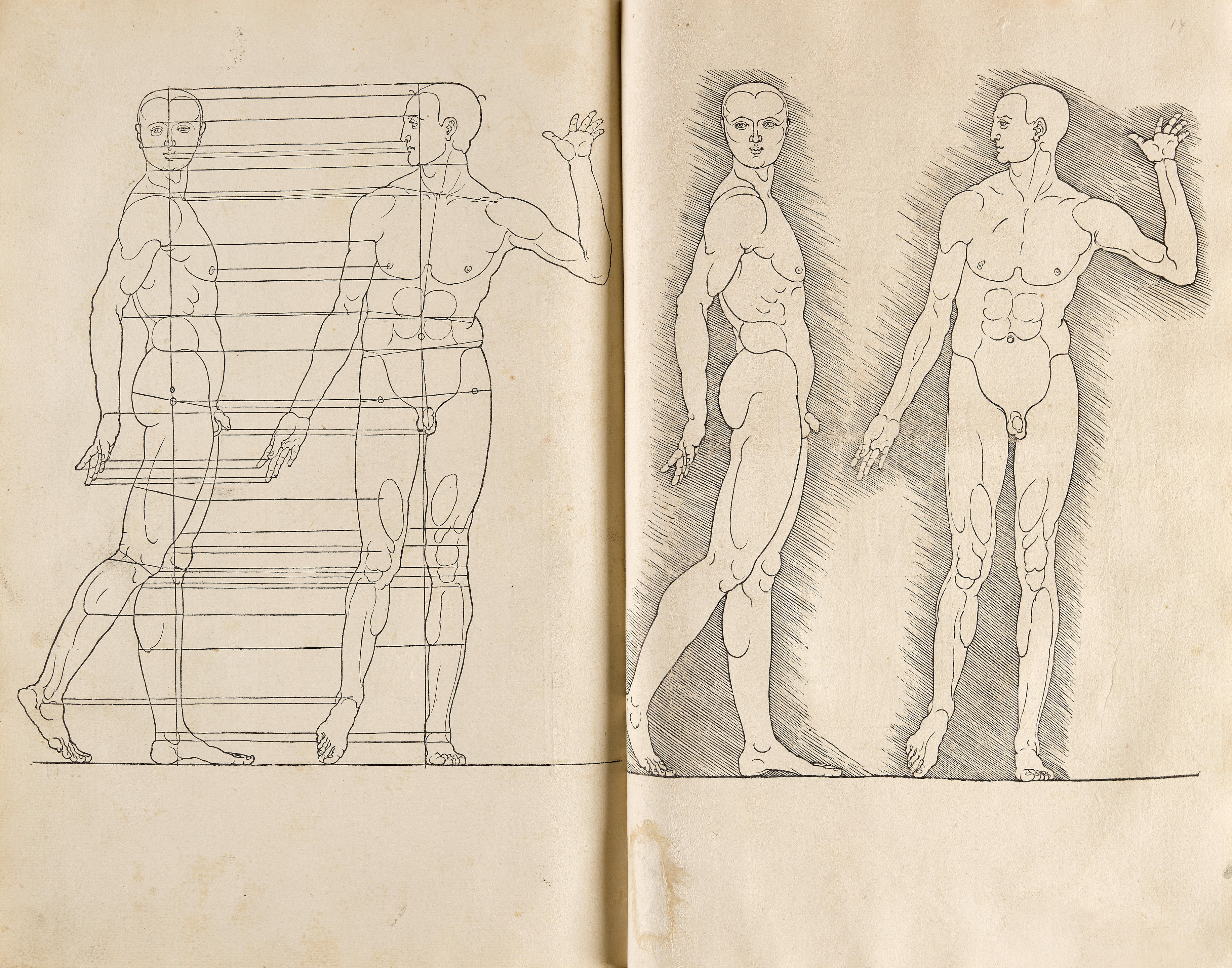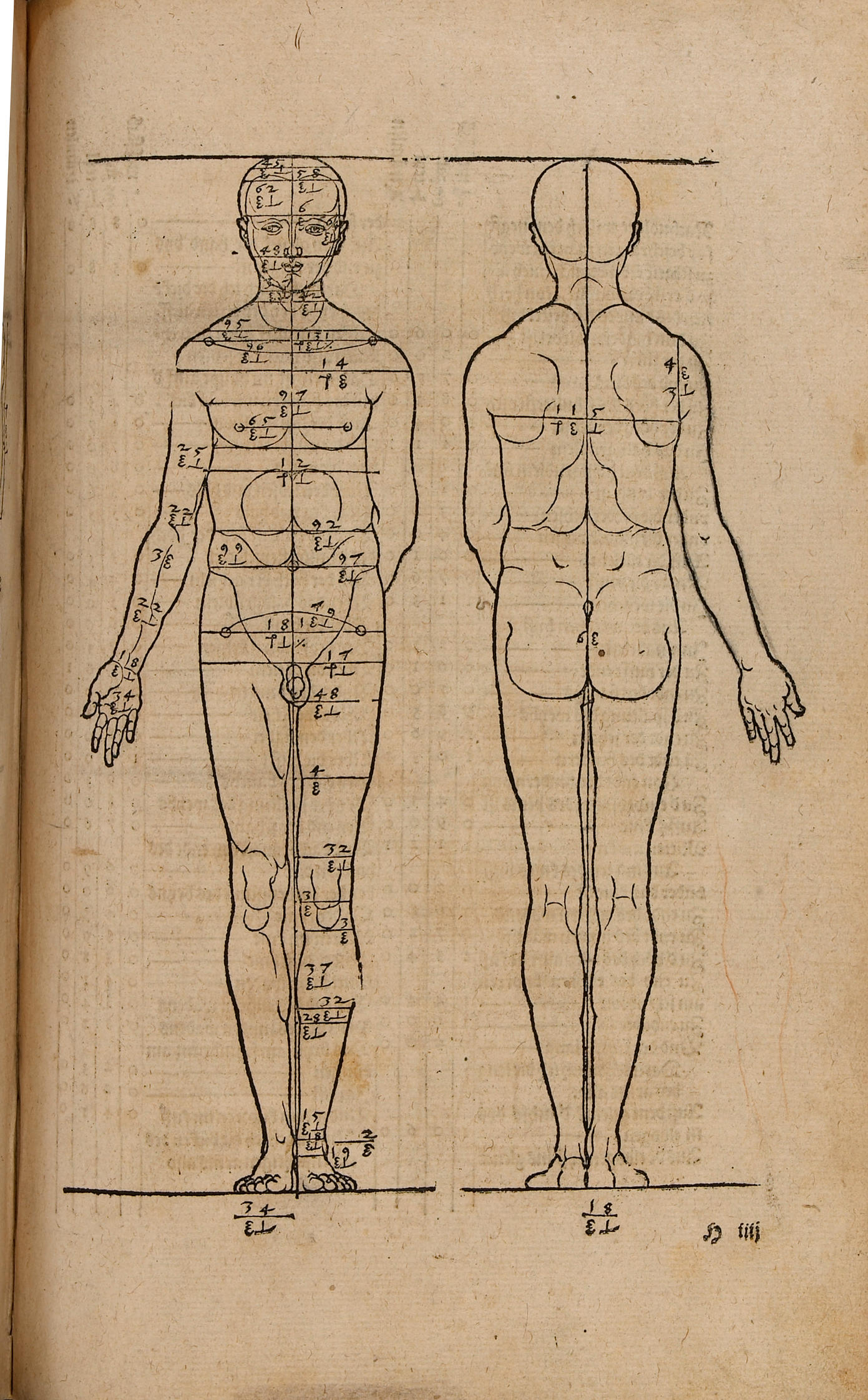DÜRER, Albrecht (1471-1528). Hierinn sind begriffen vier bücher von menschlicher Proportion . Edited by Willibald Pirckheimer. Nuremberg: Hieronymus Andreae Formschneider for Dürer's widow, 31 October 1528.
DÜRER, Albrecht (1471-1528). Hierinn sind begriffen vier bücher von menschlicher Proportion . Edited by Willibald Pirckheimer. Nuremberg: Hieronymus Andreae Formschneider for Dürer's widow, 31 October 1528. 2 o (292 x 198 mm). Gothic type, mostly double-column. Dürer's large woodcut monogram on title, approximately 136 full-length proportional woodcuts of human figures, many two to a page, and numerous smaller, geometrical or proportional woodcut diagrams, some of individual body parts (heads, arms, hands or feet), fraktur initials, flourished woodcut tail-piece ornaments, 5 fold-out sheets printed on both sides, colophon on verso of Z3 (title-page tipped in, repair to 3-in. tear on fold-out sheet S4, a few very small marginal tears and worm-holes repaired, some light marginal browning and occasional foxing). Modern vellum, large Dürer monogram inked on front cover; quarter morocco cloth case. Provenance : Eugene H. Courtiss, M.D. (his sale Christie's Los Angeles, 9 February 2000, lot 47). FIRST EDITION. Unlike his Italian contemporary, Leonardo da Vinci who published nothing, Dürer lived and worked in the world of printing and engraving. The son of a goldsmith, Dürer's godfather was Anton Koberger who left goldsmithing to become the leading printer and publisher in Nuremberg. At the age of 15 Dürer was apprenticed to the leading artist in Nuremberg, Michael Wolgemut whose workshop produced a large quantity of woodcuts. Throughout his career Dürer embraced the latest and best reproduction techniques, and may have derived more income from the sale of engravings and woodcuts than from painting. Toward the end of his life Dürer wrote and illustrated three treatises which he also designed for the press. These included a treatise on fortification, a treatise on mensuration which introduced to Northern Europe techniques of perspective and mathematical proportion in drawing, painting, architecture and letter forms, which Dürer learned in Italy, and a work on the proportion of the human body. The last work, issued shortly after Dürer's death, was the first work to discuss the problems of comparative and differential anthropometry. Because Dürer copied one of Leonardo's anatomical drawings of the upper limb into his Dresden Sketchbook we know that on one of his visits to Italy Dürer must have viewed at least some of Leonardo's anatomical drawings (see lot 3). However, unlike Leonardo who explored both the surface and the interior of the human body, Dürer appears to have limited his interest in the human figure to the surface. Dürer held that the essence of true form was the primary mathematical figure (e.g., straight line, circle, curve, conic section) constructed arithmetically or geometrically, and made beautiful by the application of a canon of proportion. However, he was also convinced that beauty of form was a relative and not an absolute quality; thus the purpose of his system of anthropometry was to provide the artist with the means to delineate, on the basis of sheer measurement, all possible types of human figures. The first two books of Dürer's work deal with the proper proportions of fat, medium and thin adult figures, as well as those of infants. The third book discusses the changing of proportions according to mathematical rules, applying these rules to both figures and faces. The fourth book treats of the movement of bodies in space, and is of the greatest mathematical interest, as it presents, for the first time, many new, intricate and difficult considerations of descriptive spatial geometry. The whole work is profusely illustrated with Dürer's woodcut diagrams of figures. Choulant-Frank states that these include "the first attempts to represent shades and shadows in wood engraving by means of cross-hatching" (p. 145). Like the Underweysung der Messung (1525), Dürer dedicated his book on human proportion to his friend Willibald Pirckheimer. Pirckheimer provided a preface describing Dürer's debt to the Italians
DÜRER, Albrecht (1471-1528). Hierinn sind begriffen vier bücher von menschlicher Proportion . Edited by Willibald Pirckheimer. Nuremberg: Hieronymus Andreae Formschneider for Dürer's widow, 31 October 1528.
DÜRER, Albrecht (1471-1528). Hierinn sind begriffen vier bücher von menschlicher Proportion . Edited by Willibald Pirckheimer. Nuremberg: Hieronymus Andreae Formschneider for Dürer's widow, 31 October 1528. 2 o (292 x 198 mm). Gothic type, mostly double-column. Dürer's large woodcut monogram on title, approximately 136 full-length proportional woodcuts of human figures, many two to a page, and numerous smaller, geometrical or proportional woodcut diagrams, some of individual body parts (heads, arms, hands or feet), fraktur initials, flourished woodcut tail-piece ornaments, 5 fold-out sheets printed on both sides, colophon on verso of Z3 (title-page tipped in, repair to 3-in. tear on fold-out sheet S4, a few very small marginal tears and worm-holes repaired, some light marginal browning and occasional foxing). Modern vellum, large Dürer monogram inked on front cover; quarter morocco cloth case. Provenance : Eugene H. Courtiss, M.D. (his sale Christie's Los Angeles, 9 February 2000, lot 47). FIRST EDITION. Unlike his Italian contemporary, Leonardo da Vinci who published nothing, Dürer lived and worked in the world of printing and engraving. The son of a goldsmith, Dürer's godfather was Anton Koberger who left goldsmithing to become the leading printer and publisher in Nuremberg. At the age of 15 Dürer was apprenticed to the leading artist in Nuremberg, Michael Wolgemut whose workshop produced a large quantity of woodcuts. Throughout his career Dürer embraced the latest and best reproduction techniques, and may have derived more income from the sale of engravings and woodcuts than from painting. Toward the end of his life Dürer wrote and illustrated three treatises which he also designed for the press. These included a treatise on fortification, a treatise on mensuration which introduced to Northern Europe techniques of perspective and mathematical proportion in drawing, painting, architecture and letter forms, which Dürer learned in Italy, and a work on the proportion of the human body. The last work, issued shortly after Dürer's death, was the first work to discuss the problems of comparative and differential anthropometry. Because Dürer copied one of Leonardo's anatomical drawings of the upper limb into his Dresden Sketchbook we know that on one of his visits to Italy Dürer must have viewed at least some of Leonardo's anatomical drawings (see lot 3). However, unlike Leonardo who explored both the surface and the interior of the human body, Dürer appears to have limited his interest in the human figure to the surface. Dürer held that the essence of true form was the primary mathematical figure (e.g., straight line, circle, curve, conic section) constructed arithmetically or geometrically, and made beautiful by the application of a canon of proportion. However, he was also convinced that beauty of form was a relative and not an absolute quality; thus the purpose of his system of anthropometry was to provide the artist with the means to delineate, on the basis of sheer measurement, all possible types of human figures. The first two books of Dürer's work deal with the proper proportions of fat, medium and thin adult figures, as well as those of infants. The third book discusses the changing of proportions according to mathematical rules, applying these rules to both figures and faces. The fourth book treats of the movement of bodies in space, and is of the greatest mathematical interest, as it presents, for the first time, many new, intricate and difficult considerations of descriptive spatial geometry. The whole work is profusely illustrated with Dürer's woodcut diagrams of figures. Choulant-Frank states that these include "the first attempts to represent shades and shadows in wood engraving by means of cross-hatching" (p. 145). Like the Underweysung der Messung (1525), Dürer dedicated his book on human proportion to his friend Willibald Pirckheimer. Pirckheimer provided a preface describing Dürer's debt to the Italians





.jpg)




Testen Sie LotSearch und seine Premium-Features 7 Tage - ohne Kosten!
Lassen Sie sich automatisch über neue Objekte in kommenden Auktionen benachrichtigen.
Suchauftrag anlegen